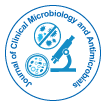
Journal of Clinical Microbiology and Antimicrobials
Open Access
+44-77-2385-9429

+44-77-2385-9429
Opinion - (2024)Volume 8, Issue 2
Antimicrobial chemotherapy stands as a fundamental of modern medicine, revolutionizing the treatment of infectious diseases and saving countless lives since its inception. From the discovery of penicillin to the challenges of Antimicrobial Resistance (AMR) in contemporary times, the evolution of antimicrobial therapies underscores both triumphs and ongoing challenges in infectious disease management.
Pioneering discoveries and early successes
The story of antimicrobial chemotherapy begins with Alexander Fleming's serendipitous discovery of penicillin in 1928, marking a pivotal moment in medical history. Penicillin and subsequent antibiotics derived from natural sources provided effective treatments for bacterial infections that were once deadly, transforming the prognosis of diseases like pneumonia, tuberculosis, and syphilis.
The 20th century witnessed a surge in antibiotic discovery and development, fueled by advancements in microbiology and medicinal chemistry. Streptomycin, tetracycline, and erythromycin were among the early antibiotics that expanded the therapeutic arsenal against a broader spectrum of bacterial pathogens. These successes fueled optimism and led to widespread adoption of antibiotics in clinical practice, ushering in an era where bacterial infections seemed conquerable.
Challenges of antimicrobial resistance
However, the widespread and often indiscriminate use of antibiotics has led to the emergence of antimicrobial resistance a global health crisis threatening the effectiveness of these lifesaving drugs. Bacteria adapt and evolve mechanisms to resist antibiotics through genetic mutations or acquisition of resistance genes from other bacteria. The rise of multidrug-resistant pathogens, such as Methicillin-Resistant Staphylococcus aureus (MRSA) and Carbapenem-Resistant Enterobacteriaceae (CRE), poses significant challenges in treating infections and increases morbidity, mortality, and healthcare costs.
Addressing AMR requires a multifaceted approach involving antimicrobial stewardship programs, infection prevention and control measures, and the development of new antibiotics and alternative therapies. The need for novel antimicrobials capable of overcoming resistance mechanisms while minimizing collateral damage to the microbiome remains important to combatting resistant infections effectively.
The role of combination therapies and personalized medicine
In response to the challenges posed by AMR, researchers are studying innovative approaches to antimicrobial chemotherapy. Combination therapies, which involve using multiple antibiotics with different mechanisms of action, offer synergistic effects and reduce the likelihood of resistance development. This strategy is particularly effective against complex infections and resistant pathogens, providing clinicians with more strong treatment options.
Advancements in personalized medicine and precision antimicrobial therapy hold assurance in customizing treatments to individual patients based on microbial profiles and resistance patterns. Rapid diagnostic technologies, such as molecular assays and whole-genome sequencing, enable timely identification of pathogens and their resistance profiles, guiding targeted therapy decisions and optimizing patient outcomes.
Analyze future frontiers: Beyond antibiotics
Looking ahead, the future of antimicrobial chemotherapy extends beyond traditional antibiotics. Research into alternative antimicrobial agents, including bacteriophages, antimicrobial peptides, and immune-based therapies, offers novel approaches to combatting infections resistant to conventional antibiotics. These therapies harness the innate capabilities of the immune system or exploit bacterial vulnerabilities in innovative ways, potentially circumventing resistance mechanisms and broadening the therapeutic landscape.
Furthermore, controlling the power of artificial intelligence and machine learning in drug discovery and development accelerates the identification of novel antimicrobial compounds and predictive modeling of resistance patterns. Collaborative efforts between academia, industry, and regulatory agencies are need to translating these scientific advancements into clinically viable treatments that address current and emerging infectious threats.
Balancing progress with prudence
Antimicrobial chemotherapy has revolutionized healthcare by providing effective treatments for infectious diseases, yet the rise of antimicrobial resistance poses formidable challenges. Preserving the efficacy of antibiotics requires a balanced approach that promotes judicious use, supports innovation in drug development, and prioritizes infection prevention strategies. Accepting interdisciplinary collaboration and leveraging technological advancements will be pivotal in shaping the future of antimicrobial therapies and safeguarding public health worldwide.
As we navigate the complexities of antimicrobial resistance and study new frontiers in treatment modalities, maintaining vigilance and stewardship in antimicrobial use are necessary to ensuring that future generations continue to benefit from the transformative impact of antimicrobial chemotherapy. By learning from the past, adopt innovation, and stimulating global cooperation, we can develop a path towards a sustainable future where effective treatments for infectious diseases remain a fundamental of modern medicine.
Citation: Octiver T (2024) Antimicrobial Chemotherapy: Introducing the Spectrum from Past to Future. J Clin Microbiol Antimicrob. 8:194
Received: 20-May-2024, Manuscript No. JCMA-24-31990 ; Editor assigned: 23-May-2024, Pre QC No. JCMA-24-31990 (PQ); Reviewed: 07-Jun-2024, QC No. JCMA-24-31990 ; Revised: 14-Jun-2024, Manuscript No. JCMA-24-31990 (R); Published: 21-Jun-2024 , DOI: 10.35248/jcma.24.8.194
Copyright: © 2024 Octiver T. This is an open-access article distributed under the terms of the Creative Commons Attribution License, which permits unrestricted use, distribution, and reproduction in any medium, provided the original author and source are credited